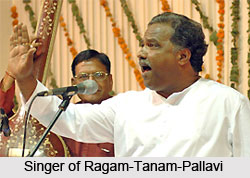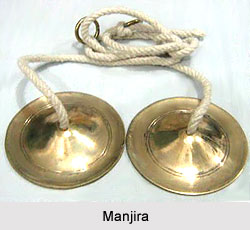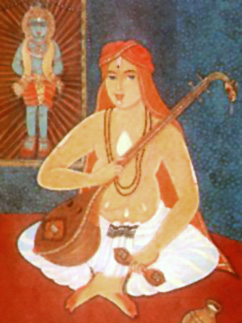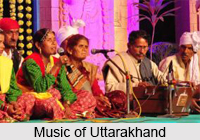 Ragam-tanam-pallavi is one of the genres of Carnatic music. The full ensemble includes a vocalist, a mridanga player and in all probability another percussionist and someone to keep the drone. The violin complements the vocal part. Frequently the vocalist and violinist pair off with the mridanga player and the other percussionist (on kanjira or ghatam), respectively. The composition of the performance ensemble is flexible.
Ragam-tanam-pallavi is one of the genres of Carnatic music. The full ensemble includes a vocalist, a mridanga player and in all probability another percussionist and someone to keep the drone. The violin complements the vocal part. Frequently the vocalist and violinist pair off with the mridanga player and the other percussionist (on kanjira or ghatam), respectively. The composition of the performance ensemble is flexible.
Performance of Ragam-tanam-pallavi
The soloist begins the ragam (or raaga alapana) with short, fairly slow phrases that reveal and explore the details of the raaga in a deliberate fashion. The violinist joins the soloist in the improvisation, repeating the soloist`s phrases and thereby forming a bridge to the next phrase. He may repeat the phrases exactly, or render them only approximately within the nutshell of the idea, but near the beginning of the performance he repeats them as closely as possible. Gradually, the soloist lengthens the lines and sings fast phrases around one pitch in the raaga. The length of time he leaves between his phrases determines how much the violinist will play alone, but the violinist may begin the repetition even before the soloist has completed the phrases. After the soloist has completed his raaga alapana, the violinist takes his turn. He usually takes approximately the same amount of time that the soloist has taken.
In tanam, the second portion of the ragam-tanam-pallavi sequence, rhythmic pulsation is established. As in Hindustani nom-tom-alap and jor, the pulsation comes and goes; it is not always consistent. In a vocal tanam, the placement of a syllable on each pitch articulation, particular types of ornamentation, and much pitch repetition create the pulsation. Melodic and rhythmic contrast is provided by slurred, non-enunciated pitches. In instrumental tanam the resources consist of plucked (therefore "enunciated") pitches, contrasting with pitches obtained by pulling or sliding along a string ("non-enunciated" pitches), and pitches obtained by the striking of the drone strings. At first, there are lapses into the free rhythm of ragam style. Once pulsation becomes consistent, the speed is increased by doubling. All of this takes place without reference to a meter.
With the pallavi, the metered portion of the ragam-tanam-pallavi sequence begins. Pallavi refers to a brief composition and also to a complete composition-plus-improvisation movement. It is a form that seems to have always contained the element of musical challenge in it, not only challenge to the soloist to perform well, but also the context for challenge by the soloist to the other members of the ensemble: solo singer to violinist, mridanga player, and secondary percussionists, such as ghatam and kanjira players.
The pallavi itself is one line of composed melody - a traditional pallavi melody, a line from some portion of a kriti (not necessarily the pallavi), or a newly composed melody. If a soloist decides to make the accompanist hear the pallavi not in advance but only during the performance, the challenge can begin at the outset. In this case, the contest of memory is already in motion, because it is the duty of the accompanists to reproduce the soloist`s pallavi perfectly after one hearing. The primary orientation of the composed pallavi is rhythmic, and the primary orientation of the improvisation that follows is similarly rhythmic. It is a "highly technical rhythmic exercise."
Pallavis are from one to six cycles long. They are constructed such that the point of principal rhythmic weight is not the first beat, but rather the halfway point in the tala cycle. The starting point of the pallavi is called the eduppu. The melody must fill the tala cycle so that it ends just before the eduppu, to allow for the repetition of the pallavi in a cyclical manner.
To begin the pallavi performance, the soloist sings the line and then repeats it once or twice. The violinist then tries to reproduce the line exactly, even bowing so as to enunciate the text. The mridanga player then joins the violinist in attempting to reproduce the rhythm exactly. Then, niraval improvisation begins. As in kriti, niraval means that the text remains the same but the melody is varied. The text must also remain at the same place in the tala cycle. In niraval, the soloist and accompanist create variations to higher and higher pitches until they reach a climax. Then they descend to the beginning point and repeat the pallavi.
It may be noted here that Tanam, the second movement in the ragam-tanam-pallavi succession, is an instrumental form in its own right when it is combined with the ragamalika idea. More specifically, it is a veena form that frequently treats the pancharagamalika (chain of five, pancha, raagas) succession of the five ghana raagas Nafa, Gauja, Arabhi, Varali, and Shri.
Many compositions group raagas in ragamalika fashion. Some of these compositions are groups of varna, some groups of kritis. The principle is to string together raagas that share one or more common pitches and are in approximately the same mood, but are definitely distinct. They should not, for example, be janya raagas of the same mela. The change in raaga should not be veiled discreetly, but should be enunciated through the citta svaras or, in the case of vocal music with text, by working the name of the raaga into the text.




